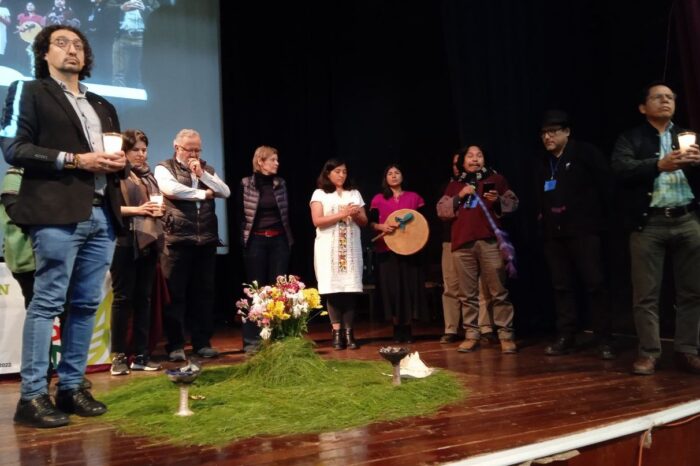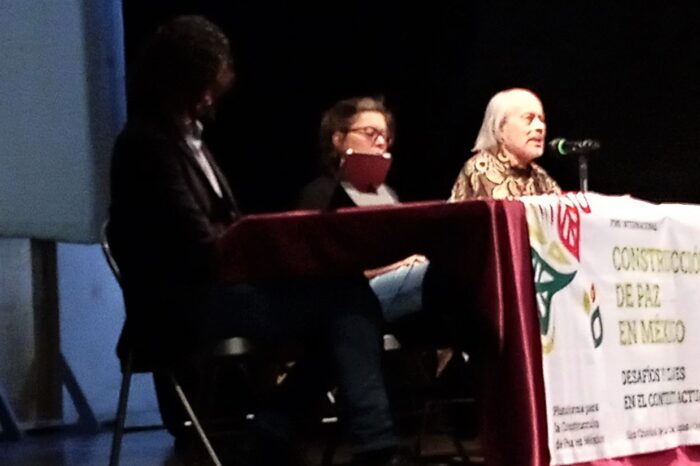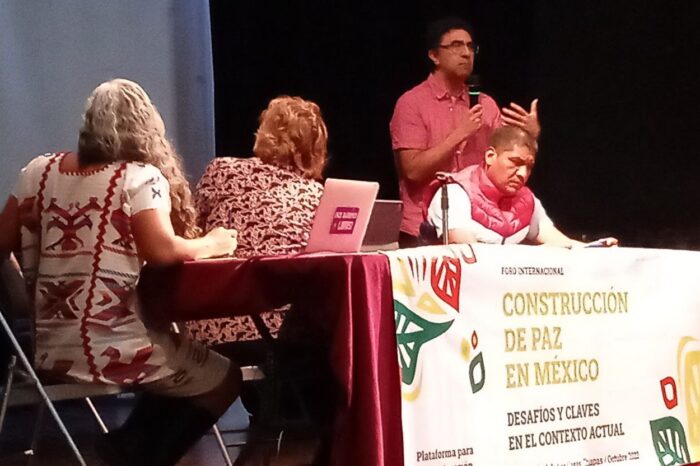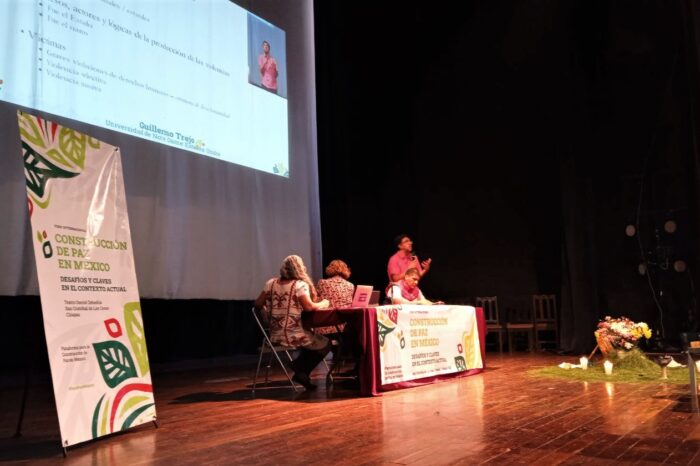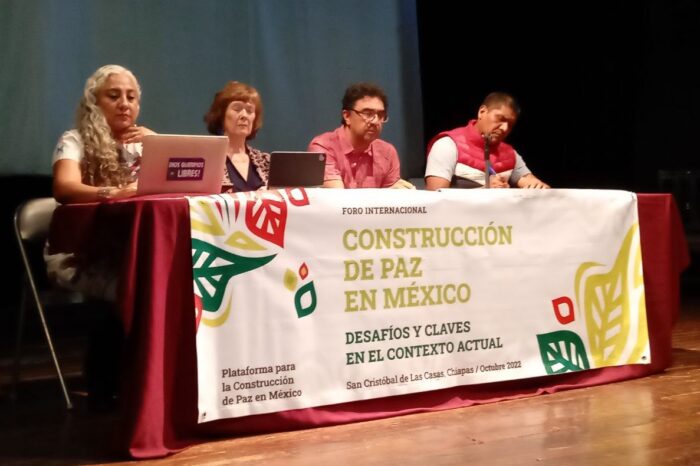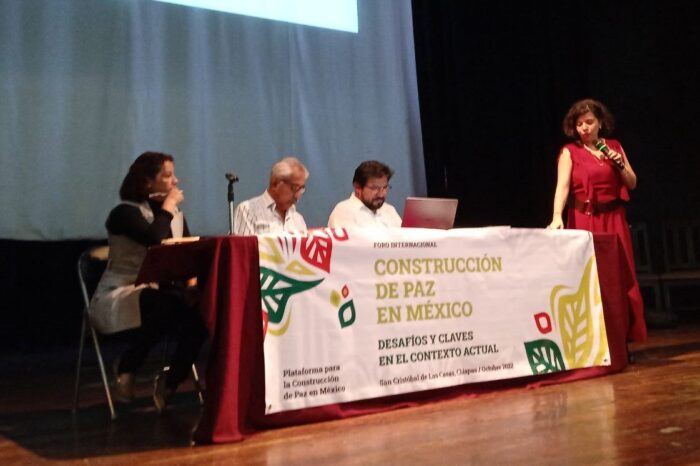Sorry, this entry is only available in Español. For the sake of viewer convenience, the content is shown below in the alternative language. You may click the link to switch the active language.
Desde el sexenio de Felipe Calderón, México inició un camino de violencia y disputa territorial que se ha venido recrudeciendo y que ha llegado a niveles alarmantes, haciendo del país la nación más peligrosa para la defensa del territorio y para el periodismo en el mundo. A esto se le suma la crisis global provocada por la pandemia del Covid-19 y la guerra en Ucrania y sus terribles consecuencias para la economía mundial y la seguridad alimentaria, provocando nuevas formas de violencia.
Ante esto, la Plataforma para la Construcción de Paz en México organizó el Foro Internacional por la Construcción de Paz en México, que se llevó a cabo el 25 de octubre de 2022 en San Cristóbal de Las Casas, Chiapas (ve el programa y l@s participantes aquí).
Las reflexiones propuestas en este foro son una contribución importante para sentipensar la espiral de violencia en la que nos encontramos y vislumbrar caminos posibles hacia la construcción de la paz.
Mesa 1 – Claves para la construcción de paz: una reflexión global
Para poder construir la paz, es necesario primero reflexionar sobre lo que significa la violencia desde enfoques locales hasta globales. Las mesas 1 y 2 incursionan en dichas reflexiones. Marta Ruiz, desde su experiencia como ex comisionada de la Comisión de la Verdad en Colombia, hace un recuento de los procesos de violencia en ese país. Así como la much@s de l@s ponentes, critica la participación del Estado en la reproducción de la violencia. Ante el argumento de que la violencia se reproduce gracias a la ausencia del Estado, ella afirma que, al contrario, la violencia se recrudece justamente cuando hay presencia del Estado, en su íntima relación con el crimen organizado y el paramilitarismo. Asimismo, identifica a la política de la “guerra contra las drogas” como un gran error histórico, que deja de lado una compreensión mucho más amplia de los factores sistémicos de dicha violencia y que conduce a la militarización y a la multiplicación de las violencias.
Luis Jorge Garay, académico y consultor internacional, también desde la experiencia colombiana, habló del cambio radical del crimen organizado en ese país desde la época de Pablo Escobar al presente, con la diversificación de las áreas de actuación y el papel de los cárteles transnacionales de origen mexicano ahora como distribuidores internacionales de la droga. Pero entender la violencia de los diferentes agentes del conflicto colombiano implica entender lo que él llama “institucionalidad extractivista”, la reproducción de la ilegalidad como una tradición nacional, en la que las élites se aprovechan de la violencia, intimidación y cooptación para apropiarse de los recursos nacionales.
El Premio Nobel de la Paz Adolfo Pérez Esquivel, con participación en línea, apuntó hacia la lucha organizada de los pueblos como la única salida para la violencia. Nuevamente, criticó la asociación entre violencia y seguridad, que conduce a la militarización y al control por parte de las fuerzas del Estado y deja de lado los ejes fundamentales de justicia restaurativa, salud, educación, vivienda digna, trabajo, unidad en la diversidad, etc.
Mesa 2 – Seguridad, justicia y territorio. ¿Cómo detener la violencia?
¿Cómo entender la violencia y el Estado? ¿Es posible la política sin violencia? Según Max Weber, el Estado mantiene (o debe mantener) el monopolio de la violencia. Sin embargo, en América Latina sabemos lo que eso significa: violaciones de derechos humanos por parte de las fuerzas policiales y el ejército, el uso de dichas fuerzas para beneficio de los intereses de las élites dominantes y la íntima relación entre el Estado y el crimen organizado. La violencia, dijo Jenny Pierce, del London School of Economics en el Reino Unido, es rentable para el Estado, y la política del “enemigo interno” sirve para esos fines. El resultado es la violencia crónica que padecemos: guerra, narco, feminicidios, migración, violencia obstétrica por discriminación y la terrible mortandad de los hombres jóvenes pobres en Latinoamérica. Como caminos posibles hacia la construcción de la paz, sugiere lo que llama la “ilustración emocional”, a diferencia de la “ilustración racional” del Iluminismo; o, como dicen los pueblos mayas en Chiapas, el corazonar o el sentipensar. Al mismo tiempo, repensar la seguridad como una propuesta comunitaria: la seguridad humana, y no la seguridad del Estado.
Guillermo Trejo, de la Universidad de Notre Dame en los Estados Unidos, habló de la “zona gris de la criminalidad”, o sea, la intersección entre el Estado y la criminalidad. Una intersección que, explicó, se construyó en los 1970 con la guerra sucia en México. La guerra contra el narco iniciada en 2006 por Felipe Calderón multiplicó los cárteles y la violencia (de 5 cárteles pasamos a más de 200), al decapitar a las organizaciones criminales, que como resultado se dividieron en muchas facciones. Por otro lado, la zona gris se amplió muy considerablemente, llevando a una “guerra de todos contra todos”, un crecimiento de las economías ilícitas, que trafican con los recursos humanos y naturales, una feroz competencia por la gobernanza criminal, con violencia generalizada contra autoridades y candidatos locales, y violencia contra periodistas, defensores de derechos humanos, sacerdotes y pequeños empresarios. Para hacer frente a esto, es necesario, como primer paso, identificar los actores y las estructuras criminales.
Como ilustración de lo que es posible hacer desde la sociedad organizada para enfrentar la violencia, Francisco Huaroco Tomás relató la experiencia de lucha y organización de Cherán K’eri en Michoacán, donde en 2011, a partir de un movimiento de mujeres para enfrentar a la delincuencia, decidieron expulsar a los partidos políticos y conformar la ronda comunitaria, un modelo de seguridad proveniente de los antepasados, enfocado en la autonomía y el autogobierno. Por otro lado, en 2015 se inició un proceso de prevención del narcomenudeo, trabajando con jóvenes en las escuelas.
Mesa 3 – Prácticas restaurativas, diálogo y reconstgrucción del tejido social
En el camino de prácticas restaurativas, diálogo y reconstrucción del tejido social, Lenin Torres relató la experiencia de CIAS por la paz (Centro de Investigación y Acción Social), fundado en 2015, y que ha trabajado en los municipios de Tancítaro, Cherán y Tangacícuaro en Michoacán; Parras, Coahuila; Huatusco, Veracruz; Celaya y Guanajuato capital en Guanajuato; y, Chalco en el Estado de México. Lina Ibáñez por su vez relató la iniciativa “Diálogos improbables” en Colombia, que se ha propuesto establecer diálogos con todas las fuerzas participantes en espacios en conflicto. Y Abel Barrera, del centro de Derechos Humanos de la Montaña Tlachinollan, relató la experiencia de la policía comunitaria de guerrero y la Coordinadora Regional de Autoridades Agrarias en Defensa del Territorio (CRAADET), que ha logrado frenar la explotación minera en partes del territorio guerrerense.
Mesa 4 – La dimensión cultural y espiritual de la construcción de paz
En la última mesa, se conjuntaron educación, espiritualidad y periodismo, como elementos fundamentales para la transformación de los mecanismos que justifican y respaldan el ejercicio de la violencia en la sociedad. Pietro Ameglio, activista y luchador social, enfatizó la necesidad de reflexionar (no sólo describir, sino analizar) como requisito para la acción. Nuevamente, criticó la asociación paz y seguridad, en vez de pensar la paz como justicia verdadera y dignidad. El Estado, explicó, necesita cuerpos aterrorizados incapaces de pensar. Nuestra tarea, al contrario, es de pasar del terror al miedo; el miedo siendo una herramienta que nos ayuda a sobrevivir y que, a diferencia del terror, no inmoviliza, sino que nos impulsa a actuar.
Marcela Turati habló de los grandes desafíos que enfrenta el periodismo en el país más peligroso para ejercer dicho oficio en el mundo, las carencias materiales y la inseguridad. Ante ese panorama, relató las muchas iniciativas vinculadas a la Red de Periodistas de a Pie, integrada en su mayoría por mujeres periodistas. Periodismo de investigación sobre las masacres de migrantes; historias de búsqueda de desaparecid@s; el proyecto Entre las cenizas: historias de vida en tiempos de muerte, que buscó rescatar historias de lucha y resistencia en medio de la mortandad de la guerra contra el narco; talleres sobre cómo cubrir el dolor (y cómo manejar el propio dolor), y la convocatoria Periodismo desde lo posible: historias desde los territorios.
Finalmente, Monseñor Rodrigo Aguilar, actual obispo de San Cristóbal de Las Casas, habló sobre la espiritualidad desde la visión cristiana.
 En Chiapas surge una pequeña organización de mujeres indígenas y mestizas que se suma a la lucha por los derechos de las mujeres, especialmente de las indígenas y afromexicanas. Con la formación y la comunicación como herramientas principales, comienzan su andar en la lucha por la vida y por la humanidad.
En Chiapas surge una pequeña organización de mujeres indígenas y mestizas que se suma a la lucha por los derechos de las mujeres, especialmente de las indígenas y afromexicanas. Con la formación y la comunicación como herramientas principales, comienzan su andar en la lucha por la vida y por la humanidad.



